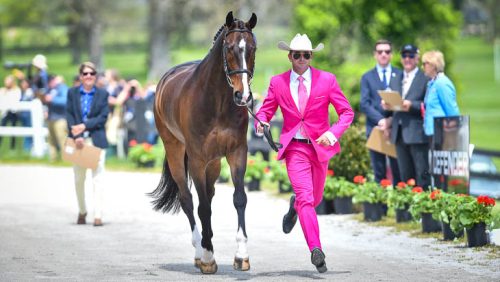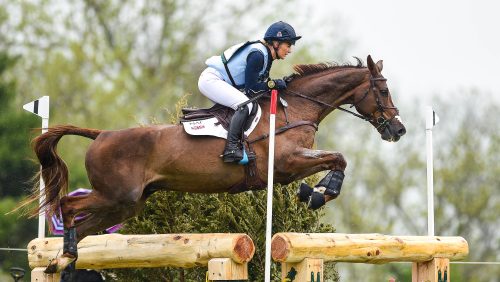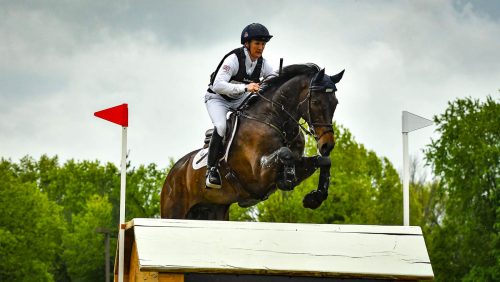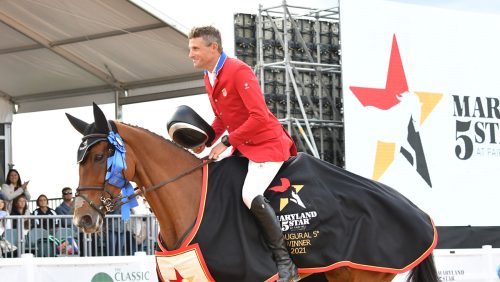Their quest to win the Rolex Kentucky CCI**** began with a centaur-like dressage test on Friday that put them 6 points in front. And when they performed a faultless show jumping round on Sunday, April 25, completing a weekend in which they added nothing to those 37 dressage penalties, the new stands at the Kentucky Horse Park in Lexington erupted with a rumble that sounded like thunder.
Winsome Adante galloped twice around the arena after crossing the finish line, as Kim Severson stroked his neck in appreciation and cried tears of joy. It was their second victory at the Rolex Kentucky four-starâ??and her third victory at Kentuckyâ??but it was really a comeback story.
“It was like we were thinking the same thing. He was totally focused on me,” Severson said with an appreciative smile. “I’ve never felt it quite that way before, at least not in the competition ring. It was quite special.”
Severson, 30, became a rising star in 1999 by winning the three-star that used to run concurrently with the four-star, and in 2002 she and Winsome Adante captured the big prize before helping the U.S. team win its gold medal at the World Championships five months later.
But a year ago Severson missed Kentucky after breaking her leg a week before the event, and then in August, while in England preparing for the Burghley CCI****, Winsome Adante had to have surgery to remove an impaction in his intestine.
For some reason, Severson said she couldn’t explain it, ever since the surgery, she and “Dan,” 11, have developed an even closer connection, a connection they proved with their remarkable dressage test.
That harmonious communication shined through again on cross-country as they made easy work of Michael Etherington-Smith’s four-star track (see sidebar) and came home more than 20 seconds fast, despite taking the long route at the Lexington Bank.
Their perfection held Phillip Dutton in second place on Nova Top, the chestnut gelding who won the Foxhall Cup CCI*** (Ga.) in 2003. Nova Top also added no penalties to his dressage score, and third-placed Abigail Lufkin on Kildonan Tug and William Fox-Pitt of Great Britain on Ballincoola did the same to claim third and fourth.
If anyone was more ecstatic than Severson, or owner Linda Wachtmeister, it was Capt. Mark Phillips, the coach of the U.S. team that will be heading for the Athens Olympics later this summer.
“Kim is the cornerstone of our medal effort in Athens,” Phillips said with certainty. “If we have Kim to anchor the team, we’re in there with a shot at the gold medal. Without Kim, we’re pushing water uphill.”
He added that he’d expected Severson to win Kentucky when the Foxhall Cup CCI*** (Ga.) ended the previous Sunday, since she’d placed second, fourth and sixth aboard three more Wachtmeister horses.
“That was huge for Kim-huge,” Phillips said. “She’s going to go to Athens riding a wave. This was so big.”
A Mental Game
Severson and Winsome Adante weren’t the only combinations with whom Phillips was giddily pleased, though.
“The sport is a mental game, and Darren’s confidence is going up as well,” the coach said of Darren Chiacchia, who rode Windfall to first place in the modified division, also just ahead of Dutton, this time on Hannigan. “To win, you’ve got to be on a roll.”
Only North American-based horses already qualified for the Olympics were allowed to contest the modified division, meaning the four British riders (who each were also riding two horses at the Badminton CCI**** the following weekend) could only ride in the regular CCI. The modified division was the first time the Olympic “CCI without steeplechase” format had ever been tested (see sidebar).
Chiacchia, 39, has now accomplished one “lifetime dream-o be in the winner’s circle at Kentucky.” And he’s on the edge of another-he Olympicsâ??with Timothy Holekamp’s Trakehner stallion, his partner since early 2001.
“I’ve prepared myself and my horse to the best of my ability, and I think he’s answered all the questions,” said Chiacchia about his Olympic prospects. Then he added, “But until it’s in print, I’m not counting on anything.”
Windfall, winner of the Pan American Championships last October, worked steadily into second place in dressage, then finished the cross-country course just 3 seconds slow before lowering the last fence on Sunday. But the dark brown stallion and Chiacchia couldn’t take the lead until Nathalie Bouckaert and West Farthing melted down in show jumping.
Bouckaert, 23, and the dark bay English-bred grabbed the early lead with a beautifully connected and brilliant dressage test, then kept their lead by also finishing 3 seconds slow. Still, Bouckaert, who lost her lead at the 2003 Foxhall Cup CCI with three displaced rails, was anxious on Saturday night.
“Today wasunbelievable,” she said after completing a four-star course on West Farthing for the first time. “But I don’t even want to think about tomorrow. Tomorrow is all about my nerves.”
And those nerves grabbed her at the very first fence, where she presented West Farthing on a weak half stride and got a refusal. Then she lowered two rails and finished 6 seconds slow, to drop to seventh.
ADVERTISEMENT
“I was trying to be really careful, and I rode him backwards to the first one,” said Bouckaert, crying as Dutton comforted her.
“I know her time is going to come,” said Dutton.
His time may come again in Athens, where he hopes to be a part of the Australian team that will be shooting for their fourth consecutive Olympic gold medal. Dutton was on the teams in 1996 and 2000, and clearly, he observed, Nova Top and Hannigan have proven themselves as four-star horses, while the falls that Connaught and I’m So Brite suffered have eliminated them from consideration.
Bruce Duchossois purchased Hannigan from Lufkin after the bay gelding made the 2000 Olympic short list with her. The Irish-bred became an unreliable jumper in the Sydney run-up, but Dutton rode him to eighth last year at the Badminton CCI**** (England).
Shannon Stimson purchased Nova Top, 13, on Dutton’s advice in late 2002, despite an inconsistent record. Dutton called him “an interesting horse,” and he’s glad now that Stimson trusted his judgment.
“He’s not a horse you just fall in love with,” said Dutton, admitting that Nova Top is usually better at three-days than at horse trials because he and his grooms can spend more time with the chestnut gelding. They rode him five times before his dressage test at 4:35 on Friday afternoon.
In addition to winning the Foxhall Cup CCI*** last year, Nova Top finished second in the Blenheim CCI*** (England). “He’s certainly not an easy horse, but if he keeps doing what he’s doing, I’ll grow even more fond of him,” said Dutton with a smile.
Olympic Ups And Downs
“We’ve got options, and that makes me very happy,” was Phillips’ evaluation of the U.S. team candidates after show jumping was over. “We don’t have a group of horses we have to patch together. We’ve got choices, because we’ve got strength and depth.”
He wouldn’t say which three riders he’d like to see join Severson and Chiacchia on the five-member team, but the candidates did their best to sort themselves out.
Bouckaert’s show jumping error put her Olympic hopes in question. Show jumping also cast doubt on Will Faudree’s aspirations as he and Antigua (sixth after another of their fast cross-country rounds) lowered three rails to fall to 10th. That score was a minor improvement, though-hey lowered four last year at Kentucky, and three at the Pan American Championships.
But two members of the team that won the gold medal at the 2002 World Championships showed that their horses will be ready for Athens.
John Williams and Carrick, who finished fourth at the Burghley CCI**** (England) last September, skipped around the cross-country course 10 seconds fast and then added 4 show jumping faults to move up to third place.
Amy Tryon’s pair of My Beau and Poggio II have gone well all spring, and 8 show jumping faults was all that kept My Beau from winning the modified division, instead of placing fourth. He finished cross-country 8 seconds slow, while Tryon rode the explosive Poggio home more conservatively, 19 seconds off the optimum time.
Stephen Bradley, who rode on the 1992 Olympic team and won Burghley in 1993 and Kentucky as a three-star in 1996, put himself back in Olympic contention by urging Fröm to fifth place with one of the modified division’s five perfect cross-country trips.
Gina Miles and McKinlaigh, bronze medalists at the 2003 FEI World Cup Final, suggested their relative inexperience in pressure situations by finishing ninth. Their dressage score suffered from some small problems, and the pair actually dropped two places after running up 9.6 time faults while narrowly escaping a fall at the Head of the Lake.
Jan Thompson, a member of the gold-medal team at the Pan American Championships on Shared Dreams, kept herself in contention with both Shared Dreams (15th) and Task Force (sixth with a faultless cross-country score). And Heidi White can keep hoping after grabbing third in dressage and ending up eighth on Northern Spy, between Bouckaert and Miles.
In the CCI, Lufkin, who made the 2000 Olympic short list with three horses but didn’t get to ride at Sydney, put herself into contention with an impressive weekend on Kildonan Tug, an Australian-bred she purchased in November after he’d completed two three-stars. Lufkin stopped riding in late 2000 to pursue a graduate degree and do social work in the Los Angeles area, and she hadn’t ridden a three-day event since Kentucky that year.
“Ever since I was 5 years old, I’ve wanted to win a medal at the Olympics, and I felt like this was a part of my life that wasn’t com-
pleted,” explained Lufkin, 33, of her return. But she says she’s less focused on the Olympics as a singular goal than she was in 2000. “I was really missing the goal of accomplishing something with my horses, with the partnership,” she said.
Jacob Two Two was one of Lufkin’s mounts in 2000, and now with Julie Burns, he’s in contention again. While Burns’ Olympic hopes took a blow when the ground jury dismissed Hyde Park Corner, the horse she rode to ninth place in the 2000 Olympics, from the modified division on Sunday morning, she guided Jacob Two Two to a faultless show jumping round to claim fifth in the CCI.
Right behind her was Bruce Davidson on Little Tricky, who finished seventh after performing a steady and polished dressage test and adding 2.8 time faults in a precise cross-country round. But 13 show jumping faults could make a difference to the selectors.
The Olympics are looking unlikely for two people who are usually a part of championship teamsâ??David and Karen O’Connor. David, winner of the Foxhall Cup CCI*** a week earlier on Outlawed, dropped to ninth in the CCI when Courting Danger wracked up 16 faults, while a nervous Tigger Too lost all chance of a top-10 finish in the modified division by placing 25th in dressage.
Karen’s best finish on her four horses was with Upstage in the modified division. The 15.2-hand rocket was one of the five who were faultless on Saturday, but he’d been 22nd in dressage and then lowered two rails.
ADVERTISEMENT
Joker’s Wild finished 24th with two re-fusals late in the cross-country course, while in the CCI Bally Mar was 16th and Grand Slam 22nd.
An Educational Experiment
No event had ever run what the Rolex Kentucky organizers called the modified three-day event, a competition Federation Equestre Internationale officials have termed “CCI without steeplechase.” And no other event will offer a four-star CCI without steeplechase before it’s run again at the Athens Olympics in September.
It was, said Phillips, a valuable experience for both the U.S. team and for the world. “We are going to be a lot smarter in August because of this. We learned a lot, and it’s going to be huge in our effort to win medals,” he said on Sunday evening.
FEI officials created the CCI without steeplechase because they sought a competition that would stress the fitness and endurance of the horses less than a three-day event. But the numbers suggest that the modified division was slightly tougher.
In the CCI, 19 horses finished cross-country with no jumping faults, seven without time faults. Another 14 had jumping faults, and three retired on course. Four horses were eliminated for falling, and three were withdrawn on Sunday morning. All told, 30 of 44 starters finished (68.18%).
In the modified division, 26 horses finished cross-country with no jumping faults, but only four with no time faults. Three horses were eliminated for falling and another three retired. Three more horses were withdrawn before show jumping, and the ground jury failed two at the final vet check. Overall, 25 of 38 starters finished (65.78%).
And if show jumping scores are an indicator of fatigue, only four modified horses recorded faultless rounds, half as many as in the four-star.
Those numbers are why Phillips thinks that FEI officials need to go back to the drawing boardâ??before the Olympics. Phillips believes that the 42 jumping efforts (the same number as the regular CCI) over a course 700 meters shorter than the CCI “is real tough. Too tough.”
He continued, “We had some of the best horses and riders in the world struggling [to finish] yesterday. Every one of them finished off the bridle.”
Bouckaert, the leader after cross-country, said that West Farthing is “normally full of run when I finish, but he was probably more tired than I’ve ever seen him” at the finish.
Said Phillips, “What the FEI has got to get right is the relationship between the number of efforts and the number of meters or Athens is going to be an ugly scene, especially since the first 21¼2 kilometers is straight uphill.”
He said he was confident that changes would be made to the course since Etherington-Smith, Kentucky’s course designer and the 2000 Olympic course de-signer, will be the technical delegate in Athens. Etherington-Smith is also a member of the FEI Eventing Committee, which writes the competition specifications.
Barry Roycroft, the Australian who was president of the ground jury, believed that “a lot of the riders underestimated the
fitness they needed. Their horses had to be four-star fit.”
And Roycroft believes that many of them have to practice being more efficient at and between the jumps, not just galloping faster to make the time. “The speed is the sameâ??570 meters per minute. And that doesn’t mean you jump at 400 meters per minute and then go 800 meters per minute,” he said.
Although the riders’ opinions were split about the course, there was consensus that the 20-minute phase A (with optional solid warm-up fences), followed by a 10-minute hold in which they were able to jump warm-up fences, didn’t work. That plan, devised by the Kentucky organizers partly as a way to keep the warm-up area under control, will not be used at Athens.
Chiacchia said that having a phase A made sense in theory, but not in practice. The rhythm was wrong, and phase A wasn’t the relaxing warm-up they expected it to be. On Power Ty, whom he rode first in the modified division, he jumped the phase A warm-up fences and then jumped “quite a few” fences in the warm-up area “since everyone else was jump, jump, jump.” But Power Ty, whose forte is cross-country, struggled to the finish line 19 seconds slow, and he suffered a heel grab that caused the ground jury to eliminate him the next morning.
So Chiacchia changed his plan with Windfall. He didn’t jump anything on phase A, and he jumped just three or four warm-up fences as soon as he reached the warm-up area, then let Windfall rest before the start, “just like in the vet box. And he did recover.”
Dutton finished second in both the CCI and the modified division. On Hannigan in the modified division, he finished 5 seconds slow (the ninth-fastest time) and then leaped from seventh to second with the only clear show jumping round in the top 10.
Like Chiacchia, Dutton would prefer to be allowed to warm-up for the testing track as he likes. But he wondered “whether people as a general rule got their horses as fit as they needed to be. The horses tended to be winded at the end.”
Dutton said that Hannigan and I’m So Brite (his two modified division starters) did basically the same conditioning program as Nova Top and Connaught (his two CCI division starters).














